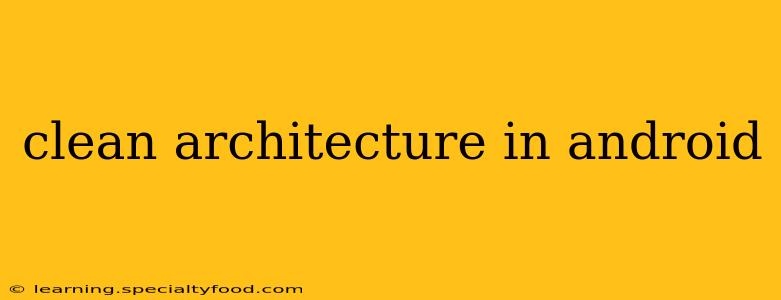Clean Architecture, a software design philosophy championed by Robert C. Martin (Uncle Bob), emphasizes separating concerns to create highly maintainable, testable, and independent Android applications. This approach allows for easier evolution, adaptation to changing requirements, and improved collaboration within development teams. This guide dives into the core principles and practical implementation of Clean Architecture in Android development.
What is Clean Architecture?
Clean Architecture prioritizes the separation of concerns by layering your application into distinct parts, each with specific responsibilities. This layered approach minimizes dependencies between layers, promoting modularity and testability. The key principle is that the inner layers should be completely independent of the outer layers, including frameworks like Android itself.
The typical layers in Clean Architecture are:
- Entities: This inner layer contains the core business logic and data models, completely independent of any frameworks or UI considerations. These are plain Java/Kotlin objects representing your application's domain.
- Use Cases: This layer contains the application's business rules and orchestrates the interactions between the entities and the data sources. They define how the data is processed and transformed.
- Interface Adapters (Presenters/View Models): This layer translates the data between the use cases and the presentation layer. This might involve formatting data for display or transforming UI events into use case requests.
- Frameworks and Drivers (UI, Database, etc.): This outermost layer contains all framework-specific code, such as the Android UI, databases, or network interactions.
Key Benefits of Clean Architecture in Android
- Testability: Independent layers allow for easy unit testing of each component in isolation.
- Maintainability: Changes in one layer have minimal impact on others, reducing the risk of cascading errors.
- Reusability: Business logic (entities and use cases) can be reused in different contexts or applications.
- Independent of Frameworks: Your application's core logic isn't tied to a specific Android version or library.
- Better Collaboration: Clear separation of concerns simplifies team collaboration.
Implementing Clean Architecture in Android: A Practical Example
Let's consider a simple example: fetching and displaying a list of users from a remote API.
1. Entities
data class User(val id: Int, val name: String, val email: String)
This is a simple data class representing a user, completely independent of any UI or data source.
2. Use Cases
class GetUsersUseCase(private val userRepository: UserRepository) {
suspend operator fun invoke(): List<User> = userRepository.getUsers()
}
interface UserRepository {
suspend fun getUsers(): List<User>
}
GetUsersUseCase interacts with UserRepository to fetch users. UserRepository is an interface, abstracting away the data source implementation.
3. Interface Adapters (ViewModel)
class UsersViewModel(private val getUsersUseCase: GetUsersUseCase) : ViewModel() {
private val _users = MutableLiveData<List<User>>()
val users: LiveData<List<User>> = _users
init {
viewModelScope.launch {
_users.value = getUsersUseCase()
}
}
}
The UsersViewModel uses the GetUsersUseCase to fetch users and exposes them as LiveData for the UI.
4. Frameworks and Drivers (UI)
// In your Activity or Fragment
viewModel.users.observe(viewLifecycleOwner) { users ->
// Update your RecyclerView with the users list
}
The UI observes the LiveData from the ViewModel and updates accordingly.
How to choose the right data source implementation?
The UserRepository interface allows you to easily switch between different data sources (e.g., network, database, local storage) without affecting other layers. You can have different implementations of UserRepository:
- NetworkUserRepository: Fetches users from a remote API.
- DatabaseUserRepository: Retrieves users from a local database.
H2: What are the best practices for implementing Clean Architecture in Android?
Following best practices is crucial for reaping the full benefits of Clean Architecture. Consider these points:
- Keep layers thin and focused: Avoid stuffing too much logic into a single layer.
- Use dependency injection: Facilitates testability and loose coupling between components. Libraries like Hilt or Koin are excellent choices.
- Favor composition over inheritance: Promotes flexibility and reusability.
- Choose appropriate data structures: Select data structures that best fit the needs of each layer.
- Thoroughly test each layer: Unit testing is essential for ensuring the correctness and robustness of your application.
H2: What are the common pitfalls to avoid when using Clean Architecture in Android?
While Clean Architecture offers significant advantages, certain pitfalls can hinder its effectiveness:
- Over-engineering: Don't apply Clean Architecture to simple projects. It adds complexity that may outweigh the benefits for small-scale apps.
- Ignoring testability: The core benefit is testability; neglecting testing negates much of the value.
- Inconsistent application: Apply the principles consistently throughout the application to avoid creating inconsistencies.
- Ignoring the context: Clean Architecture is not a one-size-fits-all solution; adapt it to the specific needs of your project.
H2: How does Clean Architecture compare to other Android architectures like MVP or MVVM?
Clean Architecture is an architectural pattern, not a specific implementation like MVP or MVVM. It provides a high-level structure, while MVP and MVVM focus on the presentation layer. You can use Clean Architecture with MVP or MVVM, often combining aspects of both for optimal results. Clean Architecture emphasizes the separation of concerns across the entire application, whereas MVP and MVVM primarily address the separation of concerns within the presentation layer.
By understanding and implementing Clean Architecture effectively, Android developers can build more robust, maintainable, and scalable applications that are easier to test and evolve over time. Remember that Clean Architecture is a journey, not a destination—continuous refinement and adaptation are essential to its successful implementation.
